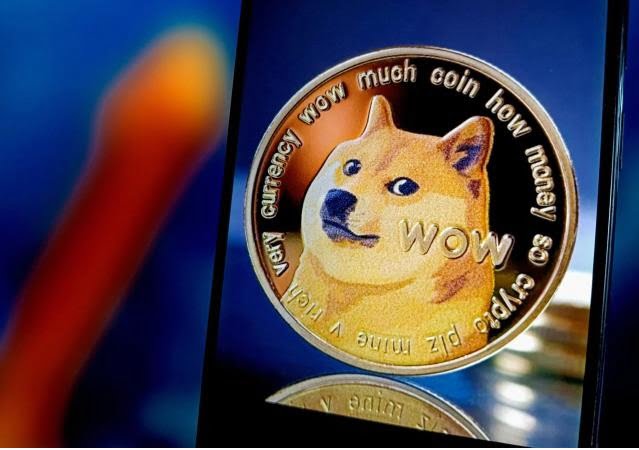Dogechain is a Proof-of-Stake (PoS) Blockchain that runs in the Polygon network, which is the largest Ethereum sidechain and is compatible with Ethereum Virtual Machine (EVM). Despite being advertised as an “Layer 2 for Dogecoin,” Dogechain isn’t a genuine layer-2 solution to this Dogecoin network. It is instead an independent EVM sidechain, which aims to provide extra benefits to Dogecoin through providing the use of decentralized financial (DeFi) as well as tokens that are not fungible (NFTs) well as Decentralized Applications (DApps), and gaming scenarios.

Dogecoin uses the Dogecoin as fuel and allows users to connect their DOGE and be rewarded with the Wrapped Dogecoin (wDOGE) in exchange. The token used by the project is $DC. It is distributed via airdrop to users. It can also be traded to earn passive income.
Dogecoin Foundation has distanced itself from the project. Dogecoin Foundation has distanced itself from Dogechain, stating that it has no affiliation with the Dogechain project. To solve problems with liquidity and interoperability, Dogechain has decided to create a brand new chain together with Polygon CDK and roll-up technology. This will improve the composability of assets and allow for interoperability with the wider EVM ecosystem.
Highlights
| Aspect | Summary |
|---|---|
| Dogechain Overview | Dogechain operates as a Proof-of-Stake (PoS) Blockchain within the Polygon network, offering additional benefits to Dogecoin through DeFi, NFTs, DApps, and gaming. Despite being termed “Layer 2 for Dogecoin,” it’s an independent EVM sidechain. The Dogecoin Foundation has no affiliation with Dogechain. |
| Dogechain Functionality | Dogechain enables users to port their DOGE to Wrapped Dogecoin (wDOGE) on its blockchain. It utilizes Polygon SDK to connect with the Dogecoin network, facilitating DeFi, GameFi, and NFT platforms. Users can interact with both Dogecoin and Dogechain networks. |
| Differences from Dogecoin | Dogechain operates on PoS consensus, unlike Dogecoin’s PoW. It offers more advanced features such as DeFi and NFTs, leveraging EVM compatibility. Governance on Dogechain involves a DAO, unlike Dogecoin’s community-driven model. Security and interoperability differ between the two. |
| Bridging Dogecoin to Dogechain | To bridge DOGE to Dogechain, users must access the Dogechain Bridge, connect their wallet, select networks, initiate the transfer (with a minimum of 100 DOGE), and receive wDOGE. They can then utilize wDOGE on Dogechain, with an optional withdrawal back to Dogecoin. |
| Staking on Dogechain | Users can stake their wDOGE on Dogechain by wrapping their DOGE, securing wDOGE, and staking it. This process involves contributing to the network and earning rewards in $DC tokens. Dogechain operates on the Ve model, where stakers can earn additional $veDC reward points. |
| Community and Disclaimer | Dogechain is a community-driven platform and is not officially affiliated with Dogecoin developers. Despite this, it offers exciting opportunities for DOGE holders to engage with DeFi and NFTs. |
What Is Dogechain?
Dogechain is an EVM (Ethereum Virtual Machine)-compatible blockchain. What does this mean? Let’s look at it this way:
- blockchain Blockchain: A blockchain works similarly to a digital ledger, which keeps track of transactions. It’s secure, decentralized, and fully transparent.
- EVM-Compatible That means Dogechain can communicate with other Ethereum-based blockchains. It’s like talking with the same tongue, which allows seamless communication between various blockchains.
- Created using Polygon SDK: Polygon is a framework that lets developers develop EVM-compatible blockchains. Dogechain utilizes this technology to connect to Dogecoin. Dogecoin network.
How Does Dogechain Work?
Dogechain’s infrastructure offers exciting possibilities for DOGE holders:
- Porting DOGE: If you’re a DOGE holder, you can port your DOGE into Dogechain. Think of it as moving your DOGE coins from one wallet to another but with added features.
- More Opportunities: Once on Dogechain, your DOGE can be part of a blockchain with more possibilities. Developers can build DeFi (Decentralized Finance), GameFi, and NFT (Non-Fungible Token) platforms using DOGE.
- Interactivity Features: Dogechain allows a connection with the DOGE blockchain. It’s like a bridge that links the two worlds.
- Wrapping Process: To move your DOGE to Dogechain, you go through a special process called wrapping. It’s like putting your DOGE in a gift box. When you wrap 100 DOGE, you get 100 wrapped DOGE (wDOGE) on your Dogechain wallet.
- Utility of wDOGE: Wrapped DOGE (wDOGE) is pegged to the value of DOGE. You can use it for blockchain governance, transaction fees, and as utility tokens on Web3 platforms.

How does Dogechain differ from the original Dogecoin blockchain?
Dogechain and the Dogecoin original blockchain differ greatly in design, purpose, and performance.
Key differences:
Purpose and Utility
- Dogecoin was initially created to make fun of people. The Dogecoin cryptocurrency is a peer-to-peer open-source cryptocurrency predominantly used for tipping donations and is an easy payment system. It relies on a proof of work (PoW) consensus system that is similar to Bitcoin and Litecoin, with a focus on payments and transactions.
- Dogechain It is designed to work in conjunction with Dogecoin; Dogechain aims to extend the use of Dogecoin by allowing accessibility to decentralized financing (DeFi) as well, Non-Futurible Tokens (NFTs) as well as Decentralized Applications (DApps), and blockchain-based games. It’s not built around the Dogecoin network but instead is an EVM-compatible proof of stake (PoS) cryptocurrency that is integrated with the Dogecoin ecosystem.
Technical Foundations
- Dogecoin uses the PoW consensus mechanism, which is used by miners to solve cryptographic challenges to validate transactions and safeguard the network. The process consumes energy and is based heavily on the Scrypt algorithm, which is less intensive than Bitcoin’s SHA-256; however, it still requires substantial computational power.
- Dogechain operates on the PoS consensus mechanism, which is more efficient in energy use and allows faster and less expensive transactions. It’s built together with Polygon Edge. It is an open-source framework that allows for the creation of customized blockchain networks using the Polygon sidechain. It is integrated with Ethereum Virtual Machine (EVM).
Security and Consensus
- Dogecoin Security is for sure because of its distributed network of miners that verify transactions and then make them available on the blockchain. The PoW system guarantees the integrity of the ledger by making it costly to modify transactions that have been made in the past.
- Dogechain It is a sidechain that Dogechain is not able to inherit any of the protections offered by the Blockchain Dogecoin. Instead, it relies on its own set of validators and does not utilize the polygon’s “security as a feature” capability. This means it is less secure than true layer-2 solutions that take advantage of the security built into their base layer.
Interoperability and Use Cases
- Dogecoin is mostly used for tipping, transactions, and for donations. It is not compatible with smart contracts, NFTs, DeFi, as well as other advanced blockchain applications.
- Dogechain It allows holders of Dogecoins to convert their DOGE in wraps of Dogecoin (wDOGE) and then use it within the Dogecoin community. This allows participation in NFT protocols, DeFi protocols, marketplaces DApps, and blockchain games, greatly expanding the possibilities of use for Dogecoin.
Governance and Community Involvement
- Dogecoin Governance is less formalized, with decisions being guided by the community as well as famous figures such as Elon Musk. There is no formal governance system.
- Dogechain The DAO operates as a Decentralized Autonomous Organization (DAO) that allows token holders to take part in governance by making suggestions, deciding on the blockchain’s parameters, and shaping the evolution and growth of its network. Its native currency, $DC, serves as a means of the governance of the organization and for staking.
In the end, even though Dogecoin is still a straightforward and widely used cryptocurrency for trades, Dogechain aims to enhance its use by providing an infrastructure for more sophisticated blockchain-related applications, by leveraging PoS as the PoS consensus mechanism as well as EVM compatibility to work with DeFi NFTs, DeFi and many more.

How can I bridge my Dogecoin to Dogechain?
To convert the Dogecoin (DOGE) to a Dogechain, you should take these steps:
- Access the Dogechain Bridge :
- Go to the Dogechain bridge site at bridge.dogechain.dog or use other bridges supported by Dogechain, such as Multichain Cross Chain Router Protocol or Synapse for cross-chain token bridges.
- Connect Your Wallet :
- Attach your wallet for cryptocurrency (e.g., MetaMask) to the Dogechain bridge. Make sure your wallet is set to manage Dogecoin and Dogechain assets.
- Select the Network and Token :
- Select the network you wish to bridge with (Dogecoin) and choose Dogechain as the destination network. After that, choose Dogecoin (DOGE) as the cryptocurrency you’d like to use to bridge.
- Initiate the Transfer :
- Select the quantity of Dogecoin you want to bridge. Remember that the minimum recharge is 100 Dogecoin.
- Verify the transaction. Multiple administrators verify the transaction and sign it, and the token is added to the recharge account specified by the user.
- Receive Wrapped Dogecoin (doge) :
- After the transaction has been confirmed, your Dogecoin will then be converted to Wrapped Dogecoin (wDOGE) through the Dogecoin network. The conversion takes place in a 1:1 ratio, which means you’ll receive one wDOGE for every DOGE that you bridge.
- Use wDOGE on Dogechain :
- You can now utilize the Dogecoin network for a variety of activities, including DeFi, yield farming NFTs, and stakes taking.
- Withdraw to Dogecoin (Optional) :
- If you want to change your WDOGE to Dogecoin, you can use the withdraw function from the bridge agreement to erase any wDOGE that is on the EVM chain and then transfer the Dogecoin you have redeemed to the address that you specified on the chain of Dogechain.
If you follow these steps, you’ll be able to successfully connect your Dogecoin with Dogechain and enjoy the extra capabilities and lower transaction fees provided by Dogechain ecosystem.

Can I stake my DOGE on Dogechain?
Yes! If you want to stake your DOGE on Dogechain to stake your DOGE, follow these steps:
- Wrap your DOGE The first step is to have to wrap the DOGE coins you originally purchased in the Dogechain blockchain. The process transforms the DOGE you have in to wrap DOGE (wDOGE). You’ll receive wDOGE as a reward. Think of it as wrapping your DOGE inside a specific wrapper.
- Secure wDOGE Once you’ve got wDOGE, you are able to stake it onto the Dogechain. Staking essentially means locking up your tokens in order to help the network and to earn rewards. In this scenario, you’ll receive the amount of $DC by staking your wDOGE.
- Ve Model Dogechain utilizes the model Ve. As a $DC holder, you can put your money into that Ve model. If you do this, you’ll be able to receive extra $veDC reward points.
Be aware that Dogechain is a community-driven platform and is it is not officially associated with Dogecoin nor its developers. However, it’s an exciting place where DOGE meets DeFi along with NFTs!
Frequently Asked Questions (FAQs)
What is the Dogechain token (DC)?
It is the Dogechain token (DC), which is the primary currency of Dogechain that is used for governance in staking and payment of transaction fees. It is a complement to wDOGE, which is used to calculate fuel costs within the system. DC token holders are able to take part in the governance process by locking their DC tokens and receiving Governance tokens (VeDC). These tokens are used to cast votes on proposed changes.
How can I use Dogechain?
To make use of Dogechain, you must connect your DOGE to the Dogechain network in order to receive the wDOGE. This is accomplished through the Dogechain bridge platform. Once you’ve installed it, you are able to use it to perform various tasks within the Dogecoin community, such as being a part of DeFi protocols trading NFTs or DApps together.
Is Dogechain safe?
Dogechain has a variety of security protocols, such as cutting to punish validators for their illegal activities. However, since Dogechain is in its beginning stage, it is advised that users be aware and learn about the bridging process in order to minimize the risk of being exposed.
How did Dogecoin start?
Dogecoin was invented by Billy Markus and Jackson Palmer as a satirical spin on Bitcoin that was inspired by the well-known Shiba Inu dog meme. It quickly gained attention because of its welcoming and sociable community.
Can Dogecoin be mined?
Dogecoin, as it were, is able to be mined with proof-of-work (PoW) algorithms that are like Bitcoin. Miners verify transactions and protect them by solving cryptographic problems.
What are the main uses of Dogecoin?
Dogecoin is used primarily to pay tips to material creators via social media, for donations to charities, and as a method of payment with merchants who accept it. It can also be traded on several cryptocurrency exchanges.
How does Dogecoin’s community contribute to its popularity?
Dogecoin’s community is renowned as generous and its active involvement in charitable activities. The community’s welcoming and friendly nature has contributed to Dogecoin’s popularity throughout the years.









